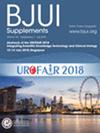ProMUS‐NET: Artificial intelligence detects more prostate cancer than urologists on micro‐ultrasonography
IF 4.4
2区 医学
Q1 UROLOGY & NEPHROLOGY
引用次数: 0
Abstract
ObjectivesTo improve sensitivity and inter‐reader consistency of prostate cancer localisation on micro‐ultrasonography (MUS) by developing a deep learning model for automatic cancer segmentation, and to compare model performance with that of expert urologists.Patients and MethodsWe performed an institutional review board‐approved prospective collection of MUS images from patients undergoing magnetic resonance imaging (MRI)‐ultrasonography fusion guided biopsy at a single institution. Patients underwent 14‐core systematic biopsy and additional targeted sampling of suspicious MRI lesions. Biopsy pathology and MRI information were cross‐referenced to annotate the locations of International Society of Urological Pathology Grade Group (GG) ≥2 clinically significant cancer on MUS images. We trained a no‐new U‐Net model – the Prostate Micro‐Ultrasound Network (ProMUS‐NET) – to localise GG ≥2 cancer on these image stacks in a fivefold cross‐validation. Performance was compared vs that of six expert urologists in a matched sub‐cohort.ResultsThe artificial intelligence (AI) model achieved an area under the receiver‐operating characteristic curve of 0.92 and detected more cancers than urologists (lesion‐level sensitivity 73% vs 58%; patient‐level sensitivity 77% vs 66%). AI lesion‐level sensitivity for peripheral zone lesions was 86.2%.ConclusionsOur AI model identified prostate cancer lesions on MUS with high sensitivity and specificity. Further work is ongoing to improve margin overlap, to reduce false positives, and to perform external validation. AI‐assisted prostate cancer detection on MUS has great potential to improve biopsy diagnosis by urologists.ProMUS - NET:人工智能比泌尿科医生在微超声检查中发现更多的前列腺癌
目的通过开发一种用于前列腺癌自动分割的深度学习模型,提高微超声(micro - ultrasound, MUS)对前列腺癌定位的灵敏度和一致性,并与泌尿科专家的模型性能进行比较。患者和方法我们进行了一项机构审查委员会批准的前瞻性收集,这些患者来自于在一家机构接受磁共振成像(MRI) -超声融合引导活检的患者。患者接受了14核心系统活检和额外的可疑MRI病变靶向取样。交叉参考活检病理和MRI信息,在MUS图像上标注国际泌尿外科病理分级组(GG)≥2级临床显著癌的位置。我们训练了一个全新的U - Net模型——前列腺微超声网络(ProMUS - Net)——在五倍交叉验证中定位这些图像堆栈上的GG≥2癌。将其与匹配亚队列中的六位泌尿科专家的表现进行比较。结果人工智能(AI)模型的受者操作特征曲线下面积为0.92,比泌尿科医生检测出更多的癌症(病变水平敏感性73% vs 58%;患者水平敏感性77% vs 66%)。AI病变水平对周围区病变的敏感性为86.2%。结论sour AI模型对MUS上的前列腺癌病变具有较高的敏感性和特异性。进一步的工作正在进行中,以改善边际重叠,减少误报,并执行外部验证。人工智能辅助前列腺癌在MUS上的检测有很大的潜力来提高泌尿科医生的活检诊断。
本文章由计算机程序翻译,如有差异,请以英文原文为准。
求助全文
约1分钟内获得全文
求助全文
来源期刊

BJU International
医学-泌尿学与肾脏学
CiteScore
9.10
自引率
4.40%
发文量
262
审稿时长
1 months
期刊介绍:
BJUI is one of the most highly respected medical journals in the world, with a truly international range of published papers and appeal. Every issue gives invaluable practical information in the form of original articles, reviews, comments, surgical education articles, and translational science articles in the field of urology. BJUI employs topical sections, and is in full colour, making it easier to browse or search for something specific.
 求助内容:
求助内容: 应助结果提醒方式:
应助结果提醒方式:


